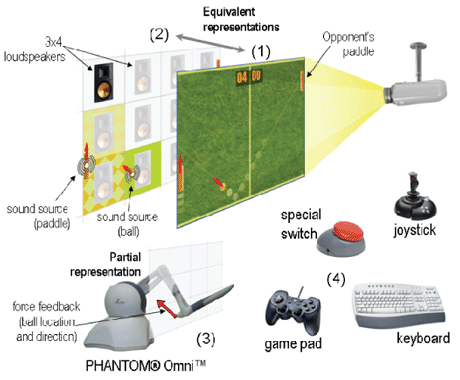by Apostolos Stamou, Anthony Savidis and Constantine Stephanidis
KING PONG, a fully accessible remake of the classic Pong game, has been developed to foster the inclusion of people with disabilities to computer game entertainment. It constitutes a research prototype of innovative display and interaction techniques that are suitable for visually and physically impaired people as well as able-bodied users, thus promoting interaction and gaming between diverse user groups.
The vast majority of existing computer games require advanced motor and sensory skills, such as simultaneous keystrokes or the concurrent use of two input devices (for instance, keyboard and mouse). In addition, the game industry is investing in 3D games in which content is conveyed entirely through 3D inaccessible artwork. The audio component of these games is usually auxiliary to the experience, its function being to improve the overall atmosphere of the game. As a result, these games are often rendered inaccessible to people with disabilities, especially those who are visually or motor impaired.
To this end, ICS-FORTH, in the context of the European IST Specific Target Research Project MICOLE (IST-2003-511592), has designed and developed KING PONG. This is a remake of the classic Pong game that was originally developed by Atari Inc., and which has been redesigned to accommodate the needs both of able-bodied and disabled players. A number of innovative display and interaction techniques have been proposed and validated by means of this research prototype, in order to encourage uptake of the proposed concepts by the game industry.
KING PONG was designed under a Universal Access and Design for All perspective, and has been evaluated both with HCI (human-computer interaction) experts and representative users. In particular, the primary goals of this work are: (a) to define appropriate design principles, building on the research in cross-modal equivalence and multi-sensory perception, which can significantly reduce the effect of certain user limitations on interaction and gaming; and (b) to increase awareness of game accessibility among developers and to extract particular guidelines for the development and assessment of accessible games while outlining potential pitfalls.

Alternative displays. KING PONG supports alternative ways of conveying game information to diverse user groups, including a visual display, a fully equivalent auditory display, and a partial haptic display. The visual display provides graphical information by means of standard display devices (eg a monitor or projector). The auditory display constitutes an auditory media space produced by a number of loudspeakers that support spatially localized audio. In this way, the game space is represented by a grid of auditory cells, and each game entity by a distinct sound source that lies within a certain cell while moving across the grid, thus allowing visually impaired players to locate them at any time. The haptic display uses the PHANTOM® Omni haptic device that presents contextual (ie partial) game information, such as the position of the ball on the game terrain and its direction. In this case, bi-manual (two-handed) interaction is supported, in which the haptic device is held by the non-dominant hand and serves as a main or auxiliary display channel, and the dominant hand is preserved for game interaction (eg controlling the paddle through an input device).
Alternative input devices. KING PONG supports a variety of input devices and assistive technology, including keyboard, special switches, joystick and game pads, thus making interaction and gaming possible regardless of the types of disability users may have.
Various player modes. KING PONG supports both a single-player mode, in which the player competes against the computer, and a two-player mode, either via sharing the same computer or over a network (Internet). In particular, the two-player mode allows gaming among people with different types of (dis)ability (eg between a blind or motor-impaired person and an able-bodied user). In addition, KING PONG supports several add-ons for addressing the needs of novice users. For instance, vibration controllers are supported in order to convey cues about the direction in which the paddle should be moved for reaching the oncoming ball.
Intelligent opponent and difficulty levels: KING PONG provides various levels of difficulty (and simulates the computer opponent in a nontrivial way), in order to ensure that gaming will be challenging and interesting for all kinds of players, with or without disabilities. We hope thereby to promote gaming and socialization between diverse user groups.
Accessible user interface: Finally, during the design of KING PONG, particular attention has been paid to accommodating good design practices in the development of an accessible and usable interface. Moreover, synthetic speech output has been integrated to allow non-visual navigation of the game menus.
Please contact:
Constantine Stephanidis
ICS-FORTH, Greece
Tel: +30 2810 391 741
E-mail: cs![]() ics.forth.gr
ics.forth.gr










